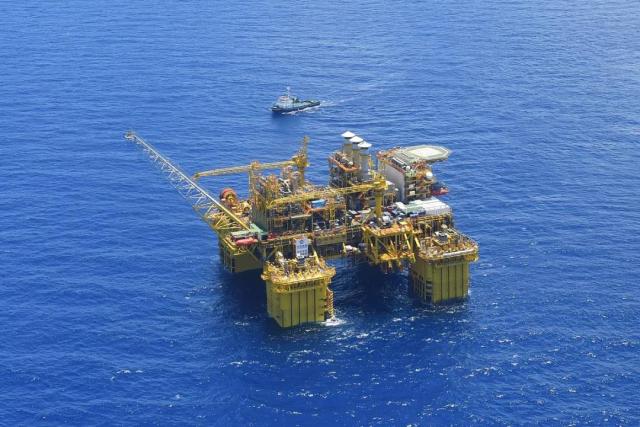浙侨英频 China widely engages in deep-sea research


Shenhai Yihao platform. [PhotoXinhua]
Shenhai Yihao platform aims to boost nation's maritime resource development
On June 25, Shenhai Yihao, the world's first 100,000 ton deep-sea, semi-submersible oil production and storage platform, began drilling at Lingshui 17-2, an offshore gas field located 150 kilometers south of Hainan island in the South China Sea.
The domestically designed platform aims to tap into the gas reserve 1,500 meters beneath the ocean surface. This single rig can produce about 3 billion cubic meters of natural gas per year, roughly 1.6 percent of China's total gas output last year, according to China National Offshore Oil Corporation.
Analysts hailed the launch of the 40-story behemoth as a new milestone in China's maritime resource development. Shenhai Yihao, or Deep Sea No 1, is the culmination of nearly two decades of deep-sea engineering ingenuity and has made China one of the few nations able to extract oil and gas with only domestically made equipment.
In a speech addressing China's top scientists and engineers in late May, President Xi Jinping urged the Chinese scientific community to break new ground in four strategic frontiers, one of which is the ocean.
Xi has been emphasizing the need to study the seas since 2013, when he uttered the famous phrase Care about the ocean, understand the ocean, and strategically manage the ocean.
Wang Pinxian, a prominent marine geologist and an academician of the Chinese Academy of Sciences, said deep-sea exploration can yield data on matters such as climate change and weather forecasts and can uncover resources including fossil fuels and minerals.
About three-fifths of Earth is covered by water with an average depth of over 2,000 meters, he said in a People's Daily article last year.
The deep sea is also the home of greenhouse gases and is a major factor in long-term climate change. If we wish to know more about Earth, we have to probe the ocean, Wang said.
On the economic front, nearly 70 percent of newly discovered oil and gas reserves are buried more than a kilometer underwater, he added.
The bottom of the sea holds a treasure trove of resources, but humanity has only barely tapped into them.
Wang said deep-sea exploration typically involves three activities diving, drilling and establishing networks.
The diving is done by manned and automated submersibles that can reach the seafloor. The drilling requires equipment that can penetrate the ocean basin. As for networks, underwater installations, cables and detectors are put in place to continuously monitor the sea floor.
China's rapid rise in deep-sea exploration in recent years is due to it making major breakthroughs in all three fields, Wang said.
Going deep
Last year, China's new manned submersible Fendouzhe, or Striver, set a national diving record of 10,909 meters in the Challenger Deep, the deepest known point of Earth's oceans.
With this feat, China became one of few countries to achieve full ocean depth capability, meaning it can carry out routine manned expeditions at any ocean depth, said Yang Rui, the scientist responsible for creating the vehicle's cabin and a researcher at the Institute of Metal Research of the Chinese Academy of Sciences.
Since the mid 20th century, scientists around the world have been going on ocean drilling expeditions from the Arctic to Antarctica. In 1998, China joined the Ocean Drilling Program, an international organization dedicated to conducting basic research on the ocean floor.
Although a latecomer to the field, China successfully extracted 5,500 meters of ocean basin sediment core samples from the South China Sea in 1999, the first samples of their kind from the region, according to the National Institute for South China Sea Studies.
The samples revealed key insights on the climate and geological formation of the region over 30 million years ago. Now, China is an active member of the International Ocean Discovery Program, the largest international scientific ocean drilling initiative with over 20 member countries.
In June, the Institute of Oceanology of the CAS reported it had successfully deployed an underwater experimental platform on the ocean floor capable of storing and studying deep-sea creatures.
Wang Minxiao, an associate researcher at the institute, said when the creatures are brought to the surface, the sudden change in pressure, temperature and chemical environment will often alter their physiological characteristics. So a lab on the ocean floor allows for a more accurate examination of deep-sea life under extreme conditions.
Find more audio news on the China Daily app.
【背景阅读】
我国首个自营1500米深水大气田“深海一号”正式投产
记者从中国海洋石油集团有限公司获悉:我国首个自营勘探开发的1500米深水大气田“深海一号”6月25日在海南陵水海域正式投产。这标志着我国海洋油气勘探开发迈向“超深水”,对保障国家能源安全、优化能源结构和促进区域经济发展具有重要意义。
“深海一号”大气田距海南省三亚市150公里,于2014年勘探发现,探明天然气储量超千亿立方米,最大水深超过1500米,最大井深达4000米以上,是我国自主发现的水深最深、勘探开发难度最大的海上深水气田。
“深海一号”大气田投产后,深水天然气将通过海底管线接入全国天然气管网,年供气量30亿立方米。
深海探测——探索海洋深处的奥秘
习近平总书记强调,要进一步关心海洋、认识海洋、经略海洋,推动我国海洋强国建设不断取得新成就。
伴随深海探测技术的发展,人类深入认识深海的时代正在来临。500年前达·芬奇设计潜水服、150年前凡尔纳写《海底两万里》,当时的科学幻想如今正在成为现实。
从科学角度看,探索深海能够帮助人类深入了解海洋的奥秘、地球的奥秘。水深超过2000米的深海,占据地球表面的35,无论温室气体排放的归宿,还是气候长期变化的源头,都要追溯到海水深层。不仅如此,海底是距离地球内部最近的地方:大陆地壳平均35公里厚,大洋地壳则为7公里。揭示板块运动的规律、窥探地球内部的真相,也要到深海底部进行探索。
从经济角度看,深海蕴藏着丰富的矿产、油气和生物资源。目前,海洋石油产量占世界石油产量的30%,高居世界海洋经济首位,其中发展最快的是深水油田。近年来全球重大油气发现,70%来自水深超过1000米的水域。海底有待开发的资源非常丰富,现在还只是起步阶段。比如海底的微生物新陈代谢极其缓慢,生殖周期在千年以上,但人类尚不知如何利用其“长寿基因”;太平洋一片深海黏土所含的稀土元素可供人类使用几十年,但开采利用技术尚待研发。
深潜、深钻、深网是当今探索深海奥秘的三大手段,即深潜科学考察、国际大洋钻探和国家海底科学观测网建设。深潜是直观的深海探索,但在空间和时间上都存在局限性。深潜最深只能到海底,从海底往下得靠钻探,这就是深钻;深潜的运行时间只能以小时计,想要长期连续观测就得将传感器放到海底,联网观测,这就是深网。深潜、深钻和深网,共同担起深海探索的技术重任。目前,我国已建立起“三深”格局,深海科考进入快速发展期。
深潜:深海探索的尖兵
明代《天工开物》中就有关于潜水的记载:屏住一口气潜入海底“没水采珠”。但是海水每加深10米就增加一个大气压,深海下潜只能在某种容器里进行。
20世纪晚期,人类在克服地心引力进入太空的同时,也顶住水柱压力进入深水海底。经过潜水钟、潜水球的试探,1960年,“的里亚斯特”号深潜器下潜到太平洋马里亚纳海沟水深10916米的海底,将两个人首次送入地球表面的最深处。经过几十年的探索,现在的深潜器已经发展为作业型,配有动力系统和各种取样设施,成为深海探索的尖兵,其突出贡献是1979年在东太平洋发现黑烟囱热液系统。上世纪80年代,美国、法国、苏联、日本分别建造了载人深潜器,最深可以潜入6500米。
我国深海科技起步较晚但发展迅速。2012年,“蛟龙”号载人深潜器下潜至7062米,创世界同类作业型潜水器最大下潜深度纪录。2017年,4500米型的“深海勇士”号载人深潜器正式投入使用,国产自主率超过95%。目前,万米级全水深的载人深潜器已经处于试验阶段,我国正迈向国际深潜设施制造前列。正是通过载人深潜,我国在南海发现了海山上成片的多金属结核、古热液区和冷水珊瑚林,在西南印度洋勘查了金属硫化物矿点。
随着自动化和人工智能的发展,探索深海也可以不用人类亲身下潜。20世纪70年代以来迅速发展的非载人深潜器,同样可以进行许多项目的科学探索,而且具有成本低、效率高的优势。世界上载人深潜器为数稀少,无人遥控潜水器则已广泛使用。由于有脐带缆和母船连接,遥控潜水器有充足的能源保障,不仅可用于长时间的科研考察,更是当前水下工程作业的主力。我国70年代末开始研制非载人深潜器,进展迅速,“海马”号4500米级遥控潜水器、“潜龙”号无人无缆自主潜水器、“海龙”号无人有缆潜水器等,正在壮大着我国深潜器的阵营。
深钻:窥探地球内部奥秘
“三深”中规模最大、需要国际合作进行的,是国际大洋钻探计划的深钻。国际大洋钻探计划从1968年开始,是由20多个国家共同参加的科学探索计划,其任务是探索深海底下的地球内部,是国际科学界为时最久、影响最大的合作计划。
大洋钻探由于技术要求高、经费投入大,必须依靠国际合作。大洋钻探每两个月执行一个钻探航次,每个航次采用的都是最先进的钻探船,科技含量极高。半个世纪来,大洋钻探在世界大洋钻井4000多口,取回岩芯40多万米,从多方面加深了人类对地球的认识。比如70年代的大洋钻探,证实了地球构造运动的板块学说,找到了气候长期变化的轨道驱动;后来的钻探又发现了海底的天然气水合物,以及地壳里微生物构成的“深部生物圈”。大洋钻探始终引领着国际地球科学的发展。
我国是大洋钻探的新兵,1998年方才参加,但在1999年就成功实施了南海第一次大洋钻探,探索季风气候演变的历史。2014至2018年间,我国又接连完成三个半钻探航次,揭示了南海海盆张裂、海底扩张的历史,使南海成为深部过程研究程度最高的边缘海。重要的是,所有这些航次都是在中国科学家提议、设计和共同主持下实施的。
深网:把“气象站”和“实验室”建在海底
世界海洋科学正在转型:从海面船只的短暂测量,转为海洋内部的长期观测。长久以来,人类主要从海洋外部观察海洋,而许多深海现象只有通过对海洋内部的长期观测才能发现。比如海洋灾害的预警,在最需要观测的时候,船只却无法靠近。90年代起,国际海洋界开始将传感器放到海底,再用光电缆接到岸上传送能量和信息。这样建成的海底观测网可以不间断地进行长期现场观测,无论有台风还是地震都可以连续运作,将深海的现场数据实时送到实验室。
进入新世纪,发达国家掀起了建设海底观测网的热潮。2009年,加拿大“海王星”观测网率先建成,水深3000米、缆线长800公里;2015年,日本建成S—Net网,从本州岛连到太平洋8000米水深的日本海沟,布设150个监测站、缆线总长5700公里,号称世界最大的地震监测网;2016年,美国OOI海底观测系统正式建成,包含区域网、近岸网、全球网三大系统,设置900多个探头对美国岸外进行多学科的海底观测;此外,欧盟14个国家参加的EMSO计划,从地中海直到北冰洋都将布设海底观测网。
海底观测网相当于在海底建立“气象站”和“实验室”,极大提升海洋观测能力,标志着新一代海洋科学的建立。从应用上讲,海底观测网是预警地震海啸最为有效的手段。世界上85%的火山在海底,布设海底装置能够实时监测火山爆发,将来或能对海底火山爆发进行“现场直播”。
我国从2005年起开始推进海底观测网的建设,2009年建设近岸的实验观测站。此后,又在南海北部进行了大量深水海流和沉积过程的长期观测。2017年,我国国家海底科学观测网正式被批复建立,将在我国东海和南海分别建立海底科学观测系统,从海底向海面进行全天候、实时和高分辨率的多界面立体综合观测。
近10年来,建设中的海底科学观测网除了光缆联网的设备外,还有着大量无线联网的活动观测平台,包括自主水下航行器、水下滑翔机、海底爬行车等。
由于深海开发尚处于起步阶段,在取得成功的同时,也时有灾难发生。2010年,墨西哥湾一口创纪录的深水油井打开了大油田,但是钻井平台爆炸导致在接下来的5个月里,50万立方米的原油漏入墨西哥湾,造成史上最严重的海上事故。进入深海不仅要防止灾害,还要关注环境保护。深海的特点在于连通性强,而且有大量的“慢过程”,深水珊瑚上千年才长一株,多金属结核百万年才长几厘米。污染物质的排放或者生态环境的破坏,后果要比在陆地严重得多。人类在深海面前还是个小学生,当前的首要任务是发展深海科技,决不能带着“淘金”的狂热去开发深海。开发深海,大量技术上的新挑战还在前面。
深海开发是面向未来的事业。如果说16世纪的“地理大发现”是人类在横向上进入海洋,21世纪将是人类在纵向上进入海洋。深潜、深钻、深网,深耕蓝色国土,建设海洋强国,我国海洋事业正在向海洋深处挺进,期待中国科学家为人类海洋事业作出更大贡献。
来源人民日报


 侨情管理信息系统
侨情管理信息系统 公众号
公众号

 浙公网安备33010302003270号
浙公网安备33010302003270号